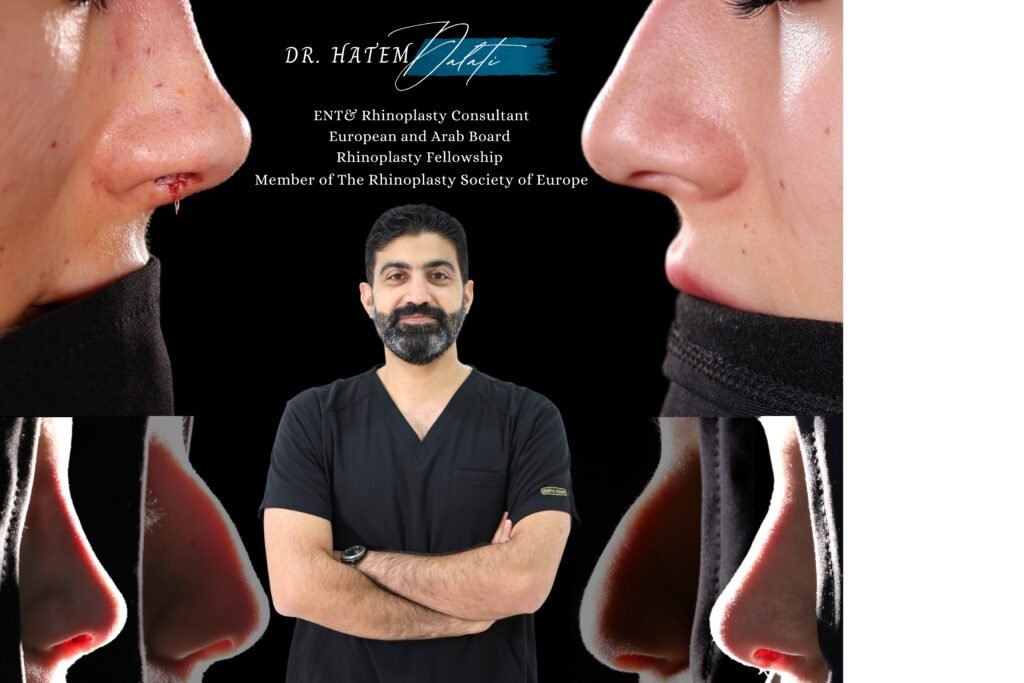
Nasal Splint After Rhinoplasty: Why It Matters for Your Recovery 👃 | Best Rhinoplasty Surgeon Dubai
Undergoing rhinoplasty is a major step toward improving your appearance and breathing — but what happens after surgery is just as important as the procedure itself. One key part of your recovery is the nasal splint. While it may not look glamorous, it plays a vital role in shaping your final results.
At our ENT clinic in Dubai, led by the best rhinoplasty surgeon Dr. Hatem Dalati, we ensure every step of your recovery is carefully guided — and that includes wearing your nasal splint the right way.
💡 What Is a Nasal Splint?
A nasal splint is a firm yet comfortable device placed on the outside of your nose immediately after surgery. It is usually made from thermoplastic or aluminum and is secured with skin-friendly tape.
Some patients may also have internal splints placed inside the nostrils to support the septum or nasal valves.
👃 Why the Nasal Splint Is So Important for Recovery
1. It Keeps Your Nose in Its New Shape
After surgery, your nose is fragile. The splint helps maintain the position of the nasal bones and cartilage as they begin to heal. Without this support, the nose could shift, resulting in an uneven or unsatisfactory appearance.
2. Reduces Swelling and Bruising
The splint applies gentle pressure to reduce post-operative swelling, especially on the bridge and nasal sidewalls. This not only improves comfort but also helps your nose settle into its refined shape.
3. Protects Against Accidental Trauma
Whether you’re sleeping, changing clothes, or out in public, the splint acts as a shield. It reduces the risk of accidental bumps or pressure that could otherwise harm your healing nose.
4. Helps Your Surgeon Monitor Healing
During follow-up appointments, the splint helps your ENT surgeon assess whether healing is on track. It ensures the nasal bones and cartilage remain where they’re intended to be.
🚫 What Happens If You Remove or Disturb It?
Tampering with or applying pressure to your splint can lead to:
- Crooked nasal bones
- Asymmetrical healing
- Increased swelling
- Possible need for revision surgery
That’s why our expert team under Dr. Hattem Dalati emphasizes strict care instructions during this period.
⏳ How Long Do You Need to Wear It?
Most patients wear the nasal splint for about 7–10 days, depending on the complexity of the surgery. During this period:
- Do not get the splint wet
- Avoid any pressure or force on the nose
- Sleep on your back with your head elevated
- Do not remove or adjust the splint on your own
Your surgeon will remove the splint safely and gently during your follow-up.
✅ Tips to Take Care of Your Nasal Splint
🛏️ Sleep on your back with your head elevated
💦 Keep the splint dry — avoid steamy showers
👓 Avoid wearing glasses directly on your nose
🚫 Do not attempt to remove or adjust the splint yourself
📆 Attend your follow-up for proper removal by your ENT surgeon
🏥 Trust the Best Rhinoplasty Surgeon in Dubai
With Dr. Hattem Dalati’s extensive experience in functional and cosmetic rhinoplasty, you’re in the hands of one of Dubai’s most trusted and skilled ENT surgeons. His precision during surgery is matched by his commitment to patient education and aftercare, ensuring the best possible results for every patient. We believe that proper aftercare — including respecting the nasal splint — is just as important as the surgery itself.
📅 Ready for a New Nose and a Confident You?
Book your consultation with the best rhinoplasty surgeon in Dubai today and let our expert team guide you through a safe, smooth, and successful transformation.
📍 Location: ENT Clinic of Excellence, Dubai Healthcare City
📞 Call/WhatsApp: +971 50 248 0249
🌐 Visit: www.entclinic.ae
📸 Follow us on Instagram, YouTube & Tiktok for expert tips & patient stories